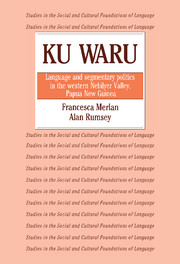Book contents
- Frontmatter
- Contents
- List of illustrations
- List of tables
- List of abbreviations
- Preface and acknowledgments
- 1 Introduction
- 2 The setting
- 3 Some aspects of Ku Waru segmentary sociality
- 4 Ceremonial exchange and marriage in the western Nebilyer Valley
- 5 Some linguistic structures of segmentary politics
- 6 Warfare compensation payment to Laulku: an analysis
- 7 Compensation at Palimung and the Kulka women's club
- 8 The events in perspective
- 9 Perspectives on ‘event’
- Appendix A Transcript of proceedings at Kailge on July 24, 1983
- Appendix B Grammatical sketch of Bo Ung, Ku Waru dialect
- Appendix C The conduct of warfare
- Appendix D Ku Waru metalinguistic expressions
- Chapter notes
- Glossary
- References
- Index
- Plate section
Appendix C - The conduct of warfare
Published online by Cambridge University Press: 30 December 2009
- Frontmatter
- Contents
- List of illustrations
- List of tables
- List of abbreviations
- Preface and acknowledgments
- 1 Introduction
- 2 The setting
- 3 Some aspects of Ku Waru segmentary sociality
- 4 Ceremonial exchange and marriage in the western Nebilyer Valley
- 5 Some linguistic structures of segmentary politics
- 6 Warfare compensation payment to Laulku: an analysis
- 7 Compensation at Palimung and the Kulka women's club
- 8 The events in perspective
- 9 Perspectives on ‘event’
- Appendix A Transcript of proceedings at Kailge on July 24, 1983
- Appendix B Grammatical sketch of Bo Ung, Ku Waru dialect
- Appendix C The conduct of warfare
- Appendix D Ku Waru metalinguistic expressions
- Chapter notes
- Glossary
- References
- Index
- Plate section
Summary
By itself, our first-hand experience of Nebilyer warfare affords little basis for generalization, since it is limited to one battle. But since it is rare to find any first-hand accounts in the anthropological literature on New Guinea warfare, it seems worthwhile for us to report on the battle in some detail. This should provide a useful supplement to other accounts such Meggitt (1977) and Koch (1974, War and Peace in Jalema). As it turns out, our experience largely corroborates those descriptions, and also provides some new evidence bearing upon the relationship between oratory, warfare, and exchange.
The battle took place on January 6, 1986. It was fought as an episode in hostilities between two regional tribe-pairs, here called Peraka-Parka and Musika-Malka, which at that time had been going on for about two years. This battle took place on the north slopes of a ridge which lies between Musika-Malka country to the south and Peraka-Parka country to the north. Except for one large eucalyptus tree at its crest, the ridge is covered by kunai grass (see Plate 9). Early on the morning of the fighting, and several times throughout the day, that grass was fired, partly in order to increase visibility across the battlefield and remove potential hiding places. The ridge is clearly visible from a neighboring area dense in homesteads some three kilometers to the north, and seeing it fired, people there correctly surmised that there would be fighting on that day (notwithstanding an earlier report that it was to start on another day). A party of men (including Alan) set out to watch, and arrived on the scene at 11.30 a.m.
- Type
- Chapter
- Information
- Ku WaruLanguage and Segmentary Politics in the Western Nebilyer Valley, Papua New Guinea, pp. 344 - 346Publisher: Cambridge University PressPrint publication year: 1991

